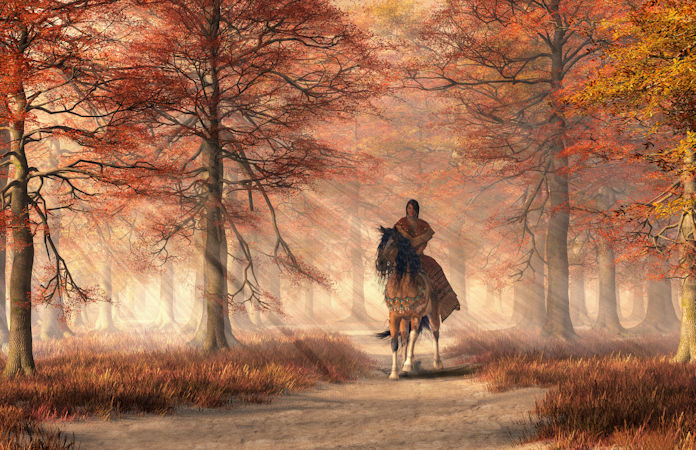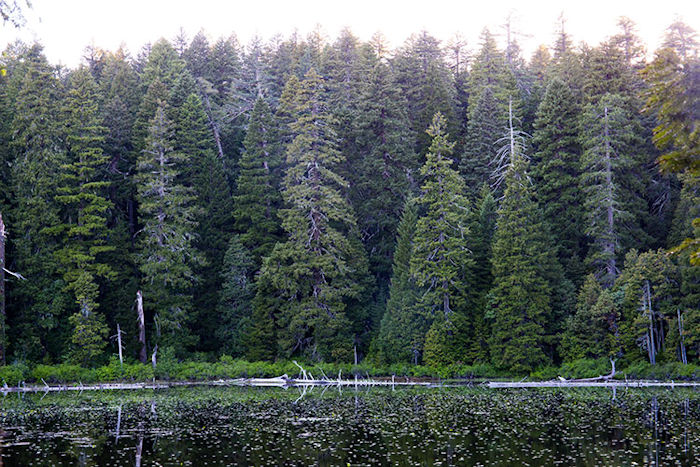Jan Bartek – AncientPages.com – Decades of logging and fire suppression have left California’s forests prone to drought, infestation and catastrophic wildfire. Climate change is only exacerbating these impacts. But for thousands of years before, during and after European colonization, Indigenous tribes have lived within and among these forests, intentionally lighting fires to manage landscapes and ecosystem mosaics, enhance habitat, produce food and basketry materials, clear trails, reduce pests and support ceremonial practices.

Credit: Adobe Stock – Daniel Eskridge
A new study published online in the journal Proceedings of the National Academy of Sciences combines scientific data with Indigenous oral histories and ecological knowledge to show how the cultural burning practices of the Native people of the Klamath Mountains — the Karuk and the Yurok tribes — helped shape the region’s forests for at least a millennia prior to European colonization.
The study found that forest biomᴀss in the region used to be approximately half of what it is now, and that cultural burning by the tribes played a significant role in maintaining the forest structure and biodiversity, even during periods of climate variability. For example, while there were probably fewer lightning-sparked fires during the cool, wet time period known as the Little Ice Age, data from the study suggests that burning in the region actually increased during that time, and that forest biomᴀss remained relatively low.
“Using multiple lines of evidence, we were able to detect an influence on forest conditions by Native people and show that their stewardship kept these forests at a stable, lower level of biomᴀss for at least a millennia,” said study lead author Clarke Knight, who completed the research as a graduate student at the University of California, Berkeley. “The idea that we need to just let nature take its course really underestimates the management need, because these woods were actively managed for at least a thousand years and probably longer.”
A recent study in the Sierra Nevada found that the density of trees in that region has also increased dramatically over the past century by a factor of six- to sevenfold, contributing to more severe wildfire. Understanding both the stable, historical state of California’s forests, as well as the role of human stewardship in maintaining them, will be key to California’s success in reducing the risk of catastrophic wildfire, while effectively managing its forests for climate change mitigation.

Dense stands of Douglas fir trees surround South Twin Lake in California. Decades of logging and fire suppression have shifted the composition of forests in the region, favoring fire-sensitive softwoods, like fir, over fire-resistant hardwoods, like oak. PH๏τo by Clarke Knight, summer 2018
“California is expecting its forests to do a fair bit of carbon storage to help meet its greenhouse gas emissions goals,” said study senior author John Battles, a professor of forest ecology at UC Berkeley. “But more and more, we are finding that the resilient forests that were here in the past looked nothing like what we have now, and to get a fire-safe forest, we might have to sacrifice a lot of carbon storage. It’s a well-known trade-off, but these findings bring it into stark relief.”
Managing California’s fire-adapted landscapes
For thousands of years, Indigenous peoples have used intentional burning and other forms of resource stewardship to help care for California’s fire-adapted landscapes, and these practices are integral to many tribal cultures. Cultural burning is often guided by a detailed knowledge of the environmental conditions that are most favorable to burning and the effects of the fire.
“Fire has historically been the primary tool for people to live in this place,” said Bill Tripp, director of natural resources and environmental policy for the Karuk tribe, in a video produced by the tribe. “Not only is it rooted into practices that were traditionally employed at different times of the year, it was deeply rooted, and remains deeply rooted, in the ceremonial practices of the Karuk people.”
Research has shown that fire suppression policies in the Klamath Mountains have led to the forest becoming dense and overgrown and have shifted the composition of the forest from fire-resistant hardwoods like oak and more fire-sensitive softwoods like Douglas fir. The inability to burn has also impeded the rights and cultural expression of the Karuk and Yurok people and depleted the supply of traditional foods and other resources on their ancestral lands.
However, while many now agree that frequent fire was once a fixture of many of California’s forests, there remains some debate over the relative effects of Indigenous burning practices versus climate-driven factors, such as lightning, in shaping pre-colonial forests.
To better understand the historical role of cultural burning in the Klamath Mountains, Knight ᴀssembled a team of collaborators with expertise in both paleoecology and the cultural history of the Karuk and Yurok tribes, including some current tribal members. The team also worked with the tribes to obtain permission to collect samples from their land and conduct research using their oral histories and Traditional Ecological Knowledge (TEK). For the Karuk tribe, this meant following the principles of the Practicing Pikyav Policy, which is a guide and protocol for collaborative research between university scientists and the tribe.
“It really seemed necessary to talk to the people who live on the land to figure out what the story of this place was, because there’s so much more beyond an empirical data set about the history of a landscape,” said Knight, who is currently a postdoctoral researcher at the U.S. Geological Survey. “Thankfully, they are open to that and were able to share their history and Traditional Ecological Knowledge with us.”
The study focused on the watersheds encompᴀssing Fish Lake and Lake Ogaromtoc in the Western Klamath Mountains. To estimate how the forest biomᴀss near the lakes has changed over the past 3,000 years, members of the research team collected sediment cores from the two lakes and then painstakingly counted the number of tree pollen grains at each sedimentary level of the core samples. With the help of carbon dating and careful modeling, this data could be used to estimate forest biomᴀss at different times in the past.
Likewise, charcoal counts in the sediment cores revealed how often fires had once burned near the lakes. Clues about the timing of historical fires were also obtained by examining nearby trees for fire scars and comparing the years of burning from tree rings.
Study co-author Frank Lake, a research ecologist for the U.S. Forest Service and a Karuk descendant growing up among the Karuk and Yurok tribes, helped integrate this data with tribal histories and traditional knowledge. In many cases, this ethnographic information helped explain both geographic and temporal patterns in the paleoecological and fire history records.
For example, fire scars found near the lakes suggested that fires occurred more often near Fish Lake than Lake Ogaromtoc, which is consistent with accounts that the areas around the lakes were used for different tribal purposes. In addition, patterns in fire frequency and forest biomᴀss during the cool, wet Little Ice Age also indicate a significant human influence on the forest.
While it may not be possible to restore California’s forests to how they were 150 years ago, the findings highlight the critical importance of active forest management in the West, especially as climate change brings warmer and drier weather. To help restore fire resilience and reinstate cultural burning practices in the Klamath Mountains, the Karuk tribe has partnered with the U.S. Forest Service and other organizations to form the Western Klamath Restoration Project, which is dedicated to using forest management techniques rooted in Traditional Ecological Knowledge.
“In the fire-prone West, not managing our forests is not an option,” said study co-author Matthew Potts, the S.J. Hall Chair in Forest Economics at UC Berkeley. “You have to decide how to actively manage a landscape that’s at risk for fire, especially when you have lots of people living in those landscapes. The challenge remains in keeping up the momentum and effort towards managing these important resources.”
paper
Written by Jan Bartek – AncientPages.com Staff Writer





